+ Open data
Open data
- Basic information
Basic information
| Entry | Database: PDB / ID: 8u4q | ||||||
|---|---|---|---|---|---|---|---|
| Title | Structure of REGN7663 Fab-bound CXCR4/Gi complex | ||||||
 Components Components |
| ||||||
 Keywords Keywords |  SIGNALING PROTEIN/IMMUNE SYSTEM / SIGNALING PROTEIN/IMMUNE SYSTEM /  GPCR / GPCR /  chemokine receptor / chemokine receptor /  antibody / antibody /  Fab / Fab /  SIGNALING PROTEIN-IMMUNE SYSTEM complex SIGNALING PROTEIN-IMMUNE SYSTEM complex | ||||||
| Function / homology |  Function and homology information Function and homology informationC-X-C motif chemokine 12 receptor activity / regulation of viral process / positive regulation of vascular wound healing / positive regulation of macrophage migration inhibitory factor signaling pathway / positive regulation of mesenchymal stem cell migration / neuron recognition / response to ultrasound / response to tacrolimus / telencephalon cell migration / C-X-C chemokine receptor activity ...C-X-C motif chemokine 12 receptor activity / regulation of viral process / positive regulation of vascular wound healing / positive regulation of macrophage migration inhibitory factor signaling pathway / positive regulation of mesenchymal stem cell migration / neuron recognition / response to ultrasound / response to tacrolimus / telencephalon cell migration / C-X-C chemokine receptor activity / Specification of primordial germ cells / CXCL12-activated CXCR4 signaling pathway /  myosin light chain binding / myosin light chain binding /  myelin maintenance / positive regulation of vasculature development / myelin maintenance / positive regulation of vasculature development /  regulation of programmed cell death / C-C chemokine receptor activity / endothelial tube morphogenesis / endothelial cell differentiation / C-C chemokine binding / Signaling by ROBO receptors / regulation of programmed cell death / C-C chemokine receptor activity / endothelial tube morphogenesis / endothelial cell differentiation / C-C chemokine binding / Signaling by ROBO receptors /  regulation of chemotaxis / cellular response to organonitrogen compound / positive regulation of chemotaxis / Formation of definitive endoderm / positive regulation of dendrite extension / anchoring junction / Chemokine receptors bind chemokines / dendritic cell chemotaxis / positive regulation of oligodendrocyte differentiation / epithelial cell development / cell leading edge / cellular response to cytokine stimulus / regulation of chemotaxis / cellular response to organonitrogen compound / positive regulation of chemotaxis / Formation of definitive endoderm / positive regulation of dendrite extension / anchoring junction / Chemokine receptors bind chemokines / dendritic cell chemotaxis / positive regulation of oligodendrocyte differentiation / epithelial cell development / cell leading edge / cellular response to cytokine stimulus /  small molecule binding / detection of temperature stimulus involved in sensory perception of pain / regulation of calcium ion transport / Adenylate cyclase inhibitory pathway / positive regulation of protein localization to cell cortex / regulation of cAMP-mediated signaling / Binding and entry of HIV virion / D2 dopamine receptor binding / G protein-coupled serotonin receptor binding / small molecule binding / detection of temperature stimulus involved in sensory perception of pain / regulation of calcium ion transport / Adenylate cyclase inhibitory pathway / positive regulation of protein localization to cell cortex / regulation of cAMP-mediated signaling / Binding and entry of HIV virion / D2 dopamine receptor binding / G protein-coupled serotonin receptor binding /  coreceptor activity / detection of mechanical stimulus involved in sensory perception of pain / coreceptor activity / detection of mechanical stimulus involved in sensory perception of pain /  regulation of cell adhesion / regulation of mitotic spindle organization / cellular response to forskolin / cardiac muscle contraction / adenylate cyclase-inhibiting G protein-coupled receptor signaling pathway / regulation of cell adhesion / regulation of mitotic spindle organization / cellular response to forskolin / cardiac muscle contraction / adenylate cyclase-inhibiting G protein-coupled receptor signaling pathway /  neurogenesis / cell chemotaxis / response to activity / neurogenesis / cell chemotaxis / response to activity /  ubiquitin binding / Regulation of insulin secretion / G protein-coupled receptor activity / G protein-coupled receptor binding / calcium-mediated signaling / ubiquitin binding / Regulation of insulin secretion / G protein-coupled receptor activity / G protein-coupled receptor binding / calcium-mediated signaling /  brain development / brain development /  neuron migration / Olfactory Signaling Pathway / G-protein beta/gamma-subunit complex binding / response to virus / Activation of the phototransduction cascade / G beta:gamma signalling through PLC beta / Presynaptic function of Kainate receptors / Thromboxane signalling through TP receptor / adenylate cyclase-modulating G protein-coupled receptor signaling pathway / G-protein activation / G protein-coupled acetylcholine receptor signaling pathway / Activation of G protein gated Potassium channels / Inhibition of voltage gated Ca2+ channels via Gbeta/gamma subunits / Prostacyclin signalling through prostacyclin receptor / Glucagon signaling in metabolic regulation / G beta:gamma signalling through CDC42 / ADP signalling through P2Y purinoceptor 12 / G beta:gamma signalling through BTK / Synthesis, secretion, and inactivation of Glucagon-like Peptide-1 (GLP-1) / Sensory perception of sweet, bitter, and umami (glutamate) taste / response to peptide hormone / photoreceptor disc membrane / Adrenaline,noradrenaline inhibits insulin secretion / Glucagon-type ligand receptors / Vasopressin regulates renal water homeostasis via Aquaporins / G alpha (z) signalling events / cellular response to catecholamine stimulus / Glucagon-like Peptide-1 (GLP1) regulates insulin secretion / ADORA2B mediated anti-inflammatory cytokines production / ADP signalling through P2Y purinoceptor 1 / adenylate cyclase-activating dopamine receptor signaling pathway / G beta:gamma signalling through PI3Kgamma / cellular response to prostaglandin E stimulus / Cooperation of PDCL (PhLP1) and TRiC/CCT in G-protein beta folding / sensory perception of taste / GPER1 signaling / GDP binding / G-protein beta-subunit binding / Inactivation, recovery and regulation of the phototransduction cascade / neuron migration / Olfactory Signaling Pathway / G-protein beta/gamma-subunit complex binding / response to virus / Activation of the phototransduction cascade / G beta:gamma signalling through PLC beta / Presynaptic function of Kainate receptors / Thromboxane signalling through TP receptor / adenylate cyclase-modulating G protein-coupled receptor signaling pathway / G-protein activation / G protein-coupled acetylcholine receptor signaling pathway / Activation of G protein gated Potassium channels / Inhibition of voltage gated Ca2+ channels via Gbeta/gamma subunits / Prostacyclin signalling through prostacyclin receptor / Glucagon signaling in metabolic regulation / G beta:gamma signalling through CDC42 / ADP signalling through P2Y purinoceptor 12 / G beta:gamma signalling through BTK / Synthesis, secretion, and inactivation of Glucagon-like Peptide-1 (GLP-1) / Sensory perception of sweet, bitter, and umami (glutamate) taste / response to peptide hormone / photoreceptor disc membrane / Adrenaline,noradrenaline inhibits insulin secretion / Glucagon-type ligand receptors / Vasopressin regulates renal water homeostasis via Aquaporins / G alpha (z) signalling events / cellular response to catecholamine stimulus / Glucagon-like Peptide-1 (GLP1) regulates insulin secretion / ADORA2B mediated anti-inflammatory cytokines production / ADP signalling through P2Y purinoceptor 1 / adenylate cyclase-activating dopamine receptor signaling pathway / G beta:gamma signalling through PI3Kgamma / cellular response to prostaglandin E stimulus / Cooperation of PDCL (PhLP1) and TRiC/CCT in G-protein beta folding / sensory perception of taste / GPER1 signaling / GDP binding / G-protein beta-subunit binding / Inactivation, recovery and regulation of the phototransduction cascade /  heterotrimeric G-protein complex / G alpha (12/13) signalling events / heterotrimeric G-protein complex / G alpha (12/13) signalling events /  extracellular vesicle extracellular vesicleSimilarity search - Function | ||||||
| Biological species |   Homo sapiens (human) Homo sapiens (human) | ||||||
| Method |  ELECTRON MICROSCOPY / ELECTRON MICROSCOPY /  single particle reconstruction / single particle reconstruction /  cryo EM / Resolution: 3.36 Å cryo EM / Resolution: 3.36 Å | ||||||
 Authors Authors | Saotome, K. / McGoldrick, L.L. / Franklin, M.C. | ||||||
| Funding support |  United States, 1items United States, 1items
| ||||||
 Citation Citation |  Journal: Biorxiv / Year: 2024 Journal: Biorxiv / Year: 2024Title: Structural insights into CXCR4 modulation and oligomerization Authors: Saotome, K. / McGoldrick, L.L. / Ho, J. / Ramlall, T. / Shah, S. / Moore, M.J. / Kim, J.H. / Leidich, R. / Olson, W.C. / Franklin, M.C. | ||||||
| History |
|
- Structure visualization
Structure visualization
| Structure viewer | Molecule:  Molmil Molmil Jmol/JSmol Jmol/JSmol |
|---|
- Downloads & links
Downloads & links
- Download
Download
| PDBx/mmCIF format |  8u4q.cif.gz 8u4q.cif.gz | 278 KB | Display |  PDBx/mmCIF format PDBx/mmCIF format |
|---|---|---|---|---|
| PDB format |  pdb8u4q.ent.gz pdb8u4q.ent.gz | 204.8 KB | Display |  PDB format PDB format |
| PDBx/mmJSON format |  8u4q.json.gz 8u4q.json.gz | Tree view |  PDBx/mmJSON format PDBx/mmJSON format | |
| Others |  Other downloads Other downloads |
-Validation report
| Arichive directory |  https://data.pdbj.org/pub/pdb/validation_reports/u4/8u4q https://data.pdbj.org/pub/pdb/validation_reports/u4/8u4q ftp://data.pdbj.org/pub/pdb/validation_reports/u4/8u4q ftp://data.pdbj.org/pub/pdb/validation_reports/u4/8u4q | HTTPS FTP |
|---|
-Related structure data
| Related structure data |  41891MC 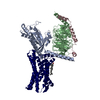 8u4nC 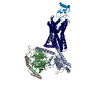 8u4oC 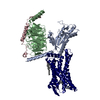 8u4pC 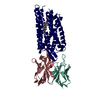 8u4rC 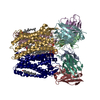 8u4sC  8u4tC M: map data used to model this data C: citing same article ( |
|---|---|
| Similar structure data | Similarity search - Function & homology  F&H Search F&H Search |
- Links
Links
- Assembly
Assembly
| Deposited unit | 
|
|---|---|
| 1 |
|
- Components
Components
-Guanine nucleotide-binding protein ... , 3 types, 3 molecules ABC
| #4: Protein | Mass: 41591.312 Da / Num. of mol.: 1 Source method: isolated from a genetically manipulated source Source: (gene. exp.)   Homo sapiens (human) / Gene: GNAI1 / Production host: Homo sapiens (human) / Gene: GNAI1 / Production host:   Spodoptera frugiperda (fall armyworm) / References: UniProt: P63096 Spodoptera frugiperda (fall armyworm) / References: UniProt: P63096 |
|---|---|
| #5: Protein | Mass: 38534.062 Da / Num. of mol.: 1 Source method: isolated from a genetically manipulated source Source: (gene. exp.)   Homo sapiens (human) / Gene: GNB1 / Production host: Homo sapiens (human) / Gene: GNB1 / Production host:   Spodoptera frugiperda (fall armyworm) / References: UniProt: P62873 Spodoptera frugiperda (fall armyworm) / References: UniProt: P62873 |
| #6: Protein | Mass: 7861.143 Da / Num. of mol.: 1 Source method: isolated from a genetically manipulated source Source: (gene. exp.)   Homo sapiens (human) / Gene: GNG2 / Production host: Homo sapiens (human) / Gene: GNG2 / Production host:   Spodoptera frugiperda (fall armyworm) / References: UniProt: P59768 Spodoptera frugiperda (fall armyworm) / References: UniProt: P59768 |
-Antibody , 2 types, 2 molecules LH
| #1: Antibody | Mass: 24185.904 Da / Num. of mol.: 1 Source method: isolated from a genetically manipulated source Source: (gene. exp.)   Homo sapiens (human) / Production host: Homo sapiens (human) / Production host:   Cricetulus griseus (Chinese hamster) Cricetulus griseus (Chinese hamster) |
|---|---|
| #2: Antibody | Mass: 25799.934 Da / Num. of mol.: 1 Source method: isolated from a genetically manipulated source Source: (gene. exp.)   Homo sapiens (human) / Production host: Homo sapiens (human) / Production host:   Cricetulus griseus (Chinese hamster) Cricetulus griseus (Chinese hamster) |
-Protein / Non-polymers , 2 types, 2 molecules R

| #3: Protein | Mass: 71063.609 Da / Num. of mol.: 1 Source method: isolated from a genetically manipulated source Source: (gene. exp.)   Homo sapiens (human) / Gene: CXCR4 / Production host: Homo sapiens (human) / Gene: CXCR4 / Production host:   Spodoptera frugiperda (fall armyworm) / References: UniProt: P61073 Spodoptera frugiperda (fall armyworm) / References: UniProt: P61073 |
|---|---|
| #7: Chemical | ChemComp-CLR /  Cholesterol Cholesterol |
-Details
| Has ligand of interest | N |
|---|
-Experimental details
-Experiment
| Experiment | Method:  ELECTRON MICROSCOPY ELECTRON MICROSCOPY |
|---|---|
| EM experiment | Aggregation state: PARTICLE / 3D reconstruction method:  single particle reconstruction single particle reconstruction |
- Sample preparation
Sample preparation
| Component | Name: REGN7663 Fab-bound CXCR4/Gi complex / Type: COMPLEX / Entity ID: #1-#6 / Source: MULTIPLE SOURCES |
|---|---|
| Molecular weight | Experimental value: NO |
| Source (natural) | Organism:   Homo sapiens (human) Homo sapiens (human) |
| Source (recombinant) | Organism:   Spodoptera frugiperda (fall armyworm) Spodoptera frugiperda (fall armyworm) |
| Buffer solution | pH: 7.5 |
| Specimen | Embedding applied: NO / Shadowing applied: NO / Staining applied : NO / Vitrification applied : NO / Vitrification applied : YES : YES |
Vitrification | Cryogen name: ETHANE |
- Electron microscopy imaging
Electron microscopy imaging
| Experimental equipment |  Model: Titan Krios / Image courtesy: FEI Company |
|---|---|
| Microscopy | Model: TFS KRIOS |
| Electron gun | Electron source : :  FIELD EMISSION GUN / Accelerating voltage: 300 kV / Illumination mode: FLOOD BEAM FIELD EMISSION GUN / Accelerating voltage: 300 kV / Illumination mode: FLOOD BEAM |
| Electron lens | Mode: BRIGHT FIELD Bright-field microscopy / Nominal defocus max: 2200 nm / Nominal defocus min: 1200 nm Bright-field microscopy / Nominal defocus max: 2200 nm / Nominal defocus min: 1200 nm |
| Image recording | Electron dose: 40 e/Å2 / Film or detector model: GATAN K3 BIOQUANTUM (6k x 4k) |
- Processing
Processing
CTF correction | Type: PHASE FLIPPING AND AMPLITUDE CORRECTION | ||||||||||||||||||||||||
|---|---|---|---|---|---|---|---|---|---|---|---|---|---|---|---|---|---|---|---|---|---|---|---|---|---|
3D reconstruction | Resolution: 3.36 Å / Resolution method: FSC 0.143 CUT-OFF / Num. of particles: 148703 / Symmetry type: POINT | ||||||||||||||||||||||||
| Refinement | Cross valid method: NONE Stereochemistry target values: GeoStd + Monomer Library + CDL v1.2 | ||||||||||||||||||||||||
| Displacement parameters | Biso mean: 56.39 Å2 | ||||||||||||||||||||||||
| Refine LS restraints |
|
 Movie
Movie Controller
Controller









 PDBj
PDBj






































